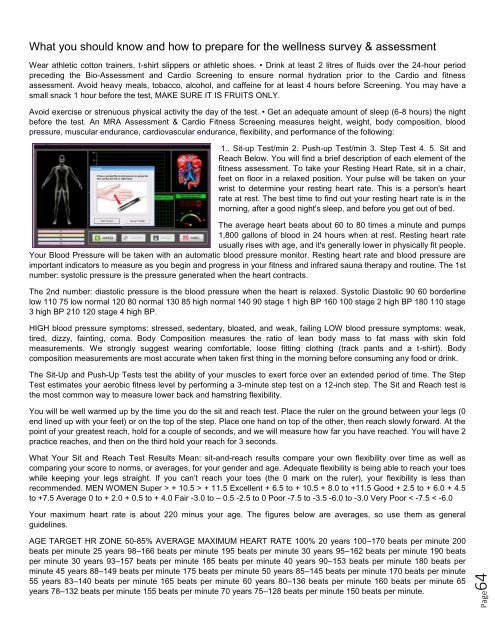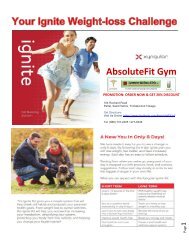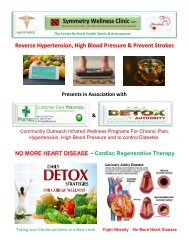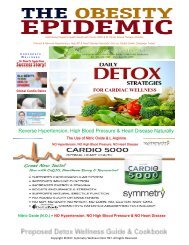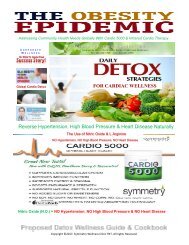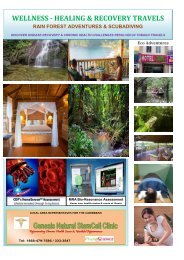Implenting Infrared Cardiac Healing Boutiques (3) 2018
Create successful ePaper yourself
Turn your PDF publications into a flip-book with our unique Google optimized e-Paper software.
What you should know and how to prepare for the wellness survey & assessment<br />
Wear athletic cotton trainers, t-shirt slippers or athletic shoes. • Drink at least 2 litres of fluids over the 24-hour period<br />
preceding the Bio-Assessment and Cardio Screening to ensure normal hydration prior to the Cardio and fitness<br />
assessment. Avoid heavy meals, tobacco, alcohol, and caffeine for at least 4 hours before Screening. You may have a<br />
small snack 1 hour before the test, MAKE SURE IT IS FRUITS ONLY.<br />
Avoid exercise or strenuous physical activity the day of the test. • Get an adequate amount of sleep (6-8 hours) the night<br />
before the test. An MRA Assessment & Cardio Fitness Screening measures height, weight, body composition, blood<br />
pressure, muscular endurance, cardiovascular endurance, flexibility, and performance of the following:<br />
1.. Sit-up Test/min 2. Push-up Test/min 3. Step Test 4. 5. Sit and<br />
Reach Below. You will find a brief description of each element of the<br />
fitness assessment. To take your Resting Heart Rate, sit in a chair,<br />
feet on floor in a relaxed position. Your pulse will be taken on your<br />
wrist to determine your resting heart rate. This is a person's heart<br />
rate at rest. The best time to find out your resting heart rate is in the<br />
morning, after a good night's sleep, and before you get out of bed.<br />
The average heart beats about 60 to 80 times a minute and pumps<br />
1,800 gallons of blood in 24 hours when at rest. Resting heart rate<br />
usually rises with age, and it's generally lower in physically fit people.<br />
Your Blood Pressure will be taken with an automatic blood pressure monitor. Resting heart rate and blood pressure are<br />
important indicators to measure as you begin and progress in your fitness and infrared sauna therapy and routine. The 1st<br />
number: systolic pressure is the pressure generated when the heart contracts.<br />
The 2nd number: diastolic pressure is the blood pressure when the heart is relaxed. Systolic Diastolic 90 60 borderline<br />
low 110 75 low normal 120 80 normal 130 85 high normal 140 90 stage 1 high BP 160 100 stage 2 high BP 180 110 stage<br />
3 high BP 210 120 stage 4 high BP.<br />
HIGH blood pressure symptoms: stressed, sedentary, bloated, and weak, failing LOW blood pressure symptoms: weak,<br />
tired, dizzy, fainting, coma. Body Composition measures the ratio of lean body mass to fat mass with skin fold<br />
measurements. We strongly suggest wearing comfortable, loose fitting clothing (track pants and a t-shirt). Body<br />
composition measurements are most accurate when taken first thing in the morning before consuming any food or drink.<br />
The Sit-Up and Push-Up Tests test the ability of your muscles to exert force over an extended period of time. The Step<br />
Test estimates your aerobic fitness level by performing a 3-minute step test on a 12-inch step. The Sit and Reach test is<br />
the most common way to measure lower back and hamstring flexibility.<br />
You will be well warmed up by the time you do the sit and reach test. Place the ruler on the ground between your legs (0<br />
end lined up with your feet) or on the top of the step. Place one hand on top of the other, then reach slowly forward. At the<br />
point of your greatest reach, hold for a couple of seconds, and we will measure how far you have reached. You will have 2<br />
practice reaches, and then on the third hold your reach for 3 seconds.<br />
What Your Sit and Reach Test Results Mean: sit-and-reach results compare your own flexibility over time as well as<br />
comparing your score to norms, or averages, for your gender and age. Adequate flexibility is being able to reach your toes<br />
while keeping your legs straight. If you can’t reach your toes (the 0 mark on the ruler), your flexibility is less than<br />
recommended. MEN WOMEN Super > + 10.5 > + 11.5 Excellent + 6.5 to + 10.5 + 8.0 to +11.5 Good + 2.5 to + 6.0 + 4.5<br />
to +7.5 Average 0 to + 2.0 + 0.5 to + 4.0 Fair -3.0 to – 0.5 -2.5 to 0 Poor -7.5 to -3.5 -6.0 to -3.0 Very Poor < -7.5 < -6.0<br />
Your maximum heart rate is about 220 minus your age. The figures below are averages, so use them as general<br />
guidelines.<br />
AGE TARGET HR ZONE 50-85% AVERAGE MAXIMUM HEART RATE 100% 20 years 100–170 beats per minute 200<br />
beats per minute 25 years 98–166 beats per minute 195 beats per minute 30 years 95–162 beats per minute 190 beats<br />
per minute 30 years 93–157 beats per minute 185 beats per minute 40 years 90–153 beats per minute 180 beats per<br />
minute 45 years 88–149 beats per minute 175 beats per minute 50 years 85–145 beats per minute 170 beats per minute<br />
55 years 83–140 beats per minute 165 beats per minute 60 years 80–136 beats per minute 160 beats per minute 65<br />
years 78–132 beats per minute 155 beats per minute 70 years 75–128 beats per minute 150 beats per minute.<br />
Page64


